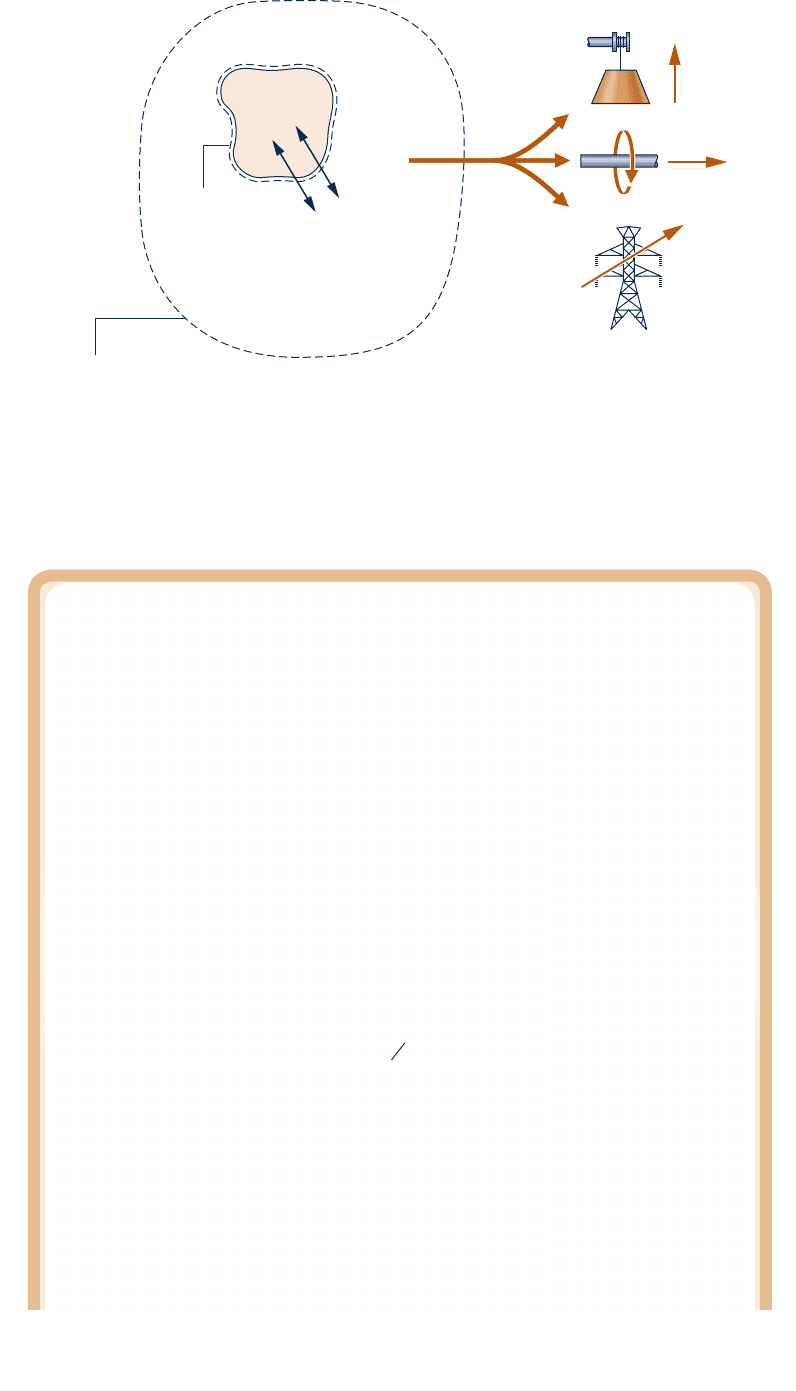Moran M.J., Shapiro H.N. Fundamentals of Engineering Thermodynamics
Подождите немного. Документ загружается.


Evaluating Exergy of a System
Referring to Fig. 7.3, exergy is the maximum theoretical value of the work W
c
obtainable
from the overall system as the closed system comes into equilibrium with the environment—
that is, as the closed system passes to the dead state.
In keeping with the discussion of Fig. 7.2, the closed system plus the environment is
referred to as the overall system. The boundary of the overall system is located so there
is no energy transfer across it by heat transfer: Q
c
5 0. Moreover, the boundary of the
overall system is located so that the total volume remains constant, even though the volumes
of the system and environment can vary. Accordingly, the work W
c
shown on the figure
is the only energy transfer across the boundary of the overall system and is fully avail-
able for lifting a weight, turning a shaft, or producing electricity in the surroundings.
Next, we apply the energy and entropy balances to determine the maximum theoretical value
for W
c.
Energy Balance
Consider a process where the system and the environment come to equilibrium. The
energy balance for the overall system is
DE
c
5 Q
c
0
2 W
c
(a)
where W
c
is the work developed by the overall system and DE
c
is the change in energy
of the overall system: the sum of the energy changes of the system and the environ-
ment. The energy of the system initially is denoted by E, which includes the kinetic,
potential, and internal energies of the system. Since the kinetic and potential energies
are evaluated relative to the environment, the energy of the system at the dead state
is just its internal energy, U
0
. Accordingly, DE
c
can be expressed as
DE
c
5 (U
0
2 E) 1 DU
e
(b)
where DU
e
is the change in internal energy of the environment.
Fig. 7.3 Overall system of system and environment used to evaluate exergy.
Heat and work
interactions with
the environment
System
boundary
Environment at T
0
, p
0
Closed
system
Boundary of the overall
system. Total volume is
constant. Q
c
= 0.
W
c
7.3 Exergy of a System 363
c07ExergyAnalysis.indd Page 363 7/12/10 6:52:18 AM user-s146c07ExergyAnalysis.indd Page 363 7/12/10 6:52:18 AM user-s146 /Users/user-s146/Desktop/Merry_X-Mas/New/Users/user-s146/Desktop/Merry_X-Mas/New

364 Chapter 7
Exergy Analysis
Since T
0
and p
0
are constant, changes in internal energy U
e
, entropy S
e
, and volume V
e
of the environment are related through Eq. 6.8, the first T dS equation, as
DU
e
5 T
0
DS
e
2 p
0
DV
e
(c)
Introducing Eq. (c) into Eq. (b) gives
DE
c
5 (U
0
2 E) 1 (T
0
DS
e
2 p
0
DV
e
) (d)
Substituting Eq. (d) into Eq. (a) and solving for W
c
gives
W
c
5 (E 2 U
0
) 2 (T
0
DS
e
2 p
0
DV
e
)
The total volume is constant. Hence, the change in volume of the environment is equal
in magnitude and opposite in sign to the volume change of the system: DV
e
5 2(V
0
2 V ).
With this substitution, the above expression for work becomes
W
c
5 (E 2 U
0
) 1 p
0
(V 2 V
0
) 2 (T
0
DS
e
) (e)
This equation gives the work for the overall system as the system passes to the dead state.
The maximum theoretical work is determined using the entropy balance as follows.
Entropy Balance
The entropy balance for the overall system reduces to
DS
c
5 s
c
where the entropy transfer term is omitted because no heat transfer takes place across
the boundary of the overall system. The term s
c
accounts for entropy production due to
irreversibilities as the system comes into equilibrium with the environment. The entropy
change DS
c
is the sum of the entropy changes for the system and environment, respec-
tively. That is
DS
c
5 (S
0
2 S) 1 DS
e
where S and S
0
denote the entropy of the system at the given state and the dead state,
respectively. Combining the last two equations
(S
0
2 S) 1 DS
e
5 s
c
(f)
Eliminating DS
e
between Eqs. (e) and (f) results in
W
c
5 (E 2 U
0
) 1 p
0
(V 2 V
0
) 2 T
0
(S 2 S
0
) 2 T
0
s
c
(g)
With E 5 U 1 KE 1 PE, Eq. (g) becomes
W
c
5 (U 2 U
0
) 1 p
0
(V 2 V
0
) 2 T
0
(S 2 S
0
) 1 KE 1 PE 2 T
0
s
c
(h)
The value of the underlined term in Eq. (h) is determined by the two end states of
the system—the given state and the dead state—and is independent of the details of the
process linking these states. However, the value of the term T
0
s
c
depends on the nature
of the process as the system passes to the dead state. In accordance with the second
law, T
0
s
c
is positive when irreversibilities are present and vanishes in the limiting case
where there are no irreversibilities. The value of T
0
s
c
cannot be negative. Hence, the
maximum theoretical value for the work of the overall system W
c
is obtained by setting
T
0
s
c
to zero in Eq. (h). By definition, this maximum value is the exergy, E. Accordingly,
Eq. 7.1 is seen to be the appropriate expression for evaluating exergy.
c07ExergyAnalysis.indd Page 364 7/12/10 6:52:19 AM user-s146c07ExergyAnalysis.indd Page 364 7/12/10 6:52:19 AM user-s146 /Users/user-s146/Desktop/Merry_X-Mas/New/Users/user-s146/Desktop/Merry_X-Mas/New

7.3.1 Exergy Aspects
In this section, we list five important aspects of the exergy concept:
Exergy is a measure of the departure of the state of a system from that of the
environment. It is therefore an attribute of the system and environment together.
However, once the environment is specified, a value can be assigned to exergy in
terms of property values for the system only, so exergy can be regarded as a prop-
erty of the system. Exergy is an extensive property.
The value of exergy cannot be negative. If a system were at any state other than the
dead state, the system would be able to change its condition spontaneously toward
the dead state; this tendency would cease when the dead state was reached. No work
must be done to effect such a spontaneous change. Accordingly, any change in state
of the system to the dead state can be accomplished with at least zero work being
developed, and thus the maximum work (exergy) cannot be negative.
Exergy is not conserved but is destroyed by irreversibilities. A limiting case is when
exergy is completely destroyed, as would occur if a system were permitted to
undergo a spontaneous change to the dead state with no provision to obtain work.
The potential to develop work that existed originally would be completely wasted
in such a spontaneous process.
Exergy has been viewed thus far as the maximum theoretical work obtainable
from an overall system of system plus environment as the system passes from a given
state to the dead state. Alternatively, exergy can be regarded as the magnitude of
the minimum theoretical work input required to bring the system from the dead
state to the given state. Using energy and entropy balances as above, we can read-
ily develop Eq. 7.1 from this viewpoint. This is left as an exercise.
When a system is at the dead state, it is in thermal and mechanical equilibrium
with the environment, and the value of exergy is zero. More precisely, the thermo-
mechanical contribution to exergy is zero. This modifying term distinguishes the
exergy concept of the present chapter from another contribution to exergy intro-
duced in Sec. 13.6, where the contents of a system at the dead state are permitted
to enter into chemical reaction with environmental components and in so doing
develop additional work. This contribution to exergy is called chemical exergy. The
chemical exergy concept is important in the second law analysis of many types of
systems, in particular systems involving combustion. Still, as shown in this chapter,
the thermomechanical exergy concept suffices for a wide range of thermodynamic
evaluations.
1.
2.
3.
4.
5.
BIOCONNECTIONS The U.S. poultry industry produces billions of pounds of
meat annually, with chicken production accounting for over 80% of the total. The
annual amount of waste produced by these birds also reaches into the billions of
pounds. The waste may be more than can be managed by disposal over cropland as fertil-
izer. Some of the excess can be used to manufacture fertilizer pellets for commercial and
domestic use. Despite its relatively low chemical exergy, poultry waste also can be used to
produce methane through anaerobic digestion. The methane can be burned in power plants
to make electricity or process steam. Digester systems are available for use right on the
farm. These are positive developments for an important sector of the U.S. agricultural
economy that has received adverse publicity for concerns over arsenic content of poultry
waste, run-off of waste into streams and rivers, and excessive odor and fly infestation in
the vicinity of huge farming operations.
7.3 Exergy of a System 365
c07ExergyAnalysis.indd Page 365 7/12/10 6:52:22 AM user-s146c07ExergyAnalysis.indd Page 365 7/12/10 6:52:22 AM user-s146 /Users/user-s146/Desktop/Merry_X-Mas/New/Users/user-s146/Desktop/Merry_X-Mas/New

366 Chapter 7 Exergy Analysis
7.3.2 Specific Exergy
Although exergy is an extensive property, it is often convenient to work with it on a unit
mass or molar basis. Expressing Eq. 7.1 on a unit mass basis, the
specific exergy, e, is
e 5 1u 2 u
0
21 p
0
1y 2 y
0
22 T
0
1s 2 s
0
21 V
2
/
2 1 gz (7.2)
where u, y, s, V
2
/2, and gz are the specific internal energy, volume, entropy, kinetic
energy, and potential energy, respectively, at the state of interest; u
0
, y
0
,
and s
0
are
specific properties at the dead state: at T
0
, p
0
. In Eq. 7.2, the kinetic and potential
energies are measured relative to the environment and thus contribute their full val-
ues to the exergy magnitude because, in principle, each could be fully converted to
work were the system brought to rest at zero elevation relative to the environment.
Finally, by inspection of Eq. 7.2, note that the units of specific exergy are the same as
for specific energy, kJ/kg or Btu/lb.
The specific exergy at a specified state requires properties at that state and at the
dead state.
let us use Eq. 7.2 to determine the specific exergy of saturated
water vapor at 1208C, having a velocity of 30 m/s and an elevation of 6 m, each
relative to an exergy reference environment where T
0
5 298 K (258C), p
0
5 1 atm,
and g 5 9.8 m/s
2
. For water as saturated vapor at 1208C, Table A-2 gives y 5
0.8919 m
3
/kg, u 5 2529.3 kJ/kg, s 5 7.1296 kJ/kg ? K. At the dead state, where T
0
5
298 K (258C) and p
0
5 1 atm, water is a liquid. Thus, with Eqs. 3.11, 3.12, and 6.5
and values from Table A-2, we get y
0
5 1.0029 3 10
23
m
3
/kg, u
0
5 104.88 kJ/kg, s
0
5
0.3674 kJ/kg ? K. Substituting values
e 5 1u 2 u
0
21 p
0
1y 2 y
0
22 T
0
1s 2 s
0
21
V
2
2
1 gz
5 c12529.3 2 104.882
kJ
kg
d
1 ca1.01325 3 10
5
N
m
2
b10.8919 2 1.0029 3 10
23
2
m
3
kg
d`
1 kJ
10
3
N ? m
`
2 c1298 K217.1296 2 0.36742
kJ
kg ? K
d
1 c
130 m
/
s2
2
2
1 a9.8
m
s
2
b16 m2d`
1 N
1 kg ? m
/
s
2
``
1 kJ
10
3
N ? m
`
5 12424.42 1 90.27 2 2015.14 1 0.45 1 0.062
k
J
kg
5 500
kJ
kg
b b b b b
The following example illustrates the use of Eq. 7.2 together with ideal gas
property data.
specific exergy
Evaluating the Exergy of Exhaust Gas
c c c c EXAMPLE 7.1 c
A cylinder of an internal combustion engine contains 2450 cm
3
of gaseous combustion products at a pressure of
7 bar and a temperature of 8678C just before the exhaust valve opens. Determine the specific exergy of the gas,
in kJ/kg. Ignore the effects of motion and gravity, and model the combustion products as air behaving as an ideal
gas. Take T
0
5 300 K (278C) and p
0
5 1.013 bar.
SOLUTION
Known:
Gaseous combustion products at a specified state are contained in the cylinder of an internal combustion
engine.
6 m
z
Saturated
vapor at 120°
C
30 m/s
p
0
= 1 atm
T
0
= 298 K
g = 9.8 m/s
2
TAKE NOTE...
Kinetic and potential energy
are rightfully considered as
exergy. But for simplicity of
expression in the present
chapter, we refer to these
terms—whether viewed as
energy or exergy—as
accounting for the effects
of motion and gravity.
The meaning will be clear
in context.
c07ExergyAnalysis.indd Page 366 7/12/10 6:52:22 AM user-s146c07ExergyAnalysis.indd Page 366 7/12/10 6:52:22 AM user-s146 /Users/user-s146/Desktop/Merry_X-Mas/New/Users/user-s146/Desktop/Merry_X-Mas/New

Find: Determine the specific exergy.
Schematic and Given Data:
To what elevation, in m, would a 1-kg mass have to be raised from
zero elevation with respect to the reference environment for its exergy to
equal that of the gas in the cylinder? Assume g 5 9.81 m/s
2
. Ans. 197 m.
Analysis: With assumption 3, Eq. 7.2 becomes
e 5 u 2 u
0
1 p
0
1y 2 y
0
22 T
0
1s 2 s
0
2
The internal energy and entropy terms are evaluated using data from Table A-22, as follows:
u 2 u
0
5 1880.35 2 214.072 kJ
/
kg
5 666.28 kJ
/
kg
s 2 s
0
5 s81T22 s81T
0
22
R
M
ln
p
p
0
5 a3.11883 2 1.70203 2 a
8.314
28.97
b ln a
7
1.013
bb
kJ
kg ? K
5 0.8621 kJ
/
kg ? K
T
0
1s 2 s
0
25 1300 K210.8621 kJ
/
kg ? K2
5 258.62 kJ
/
kg
The p
0
(y 2 y
0
) term is evaluated using the ideal gas equation of state: y 5 1R
/
M2T
/
p and y
0
5 1R
/
M2T
0
/
p
0
, so
p
0
1y 2 y
0
25
R
M
a
p
0
T
p
2 T
0
b
5
8.314
28.97
a
11.013211140
2
7
2 300b
k
J
kg
5238.75 kJ
/
kg
Substituting values into the above expression for the specific exergy
e 5 1666.28 1 1238.7522 258.622 kJ
/
kg
➊ 5 368.91 kJ
/
kg
➊ If the gases are discharged directly to the surroundings, the potential for
developing work quantified by the exergy value determined in the solution
is wasted. However, by venting the gases through a turbine, some work could
be developed. This principle is utilized by the turbochargers added to some
internal combustion engines.
Ability to…
❑
evaluate specific exergy.
❑
apply the ideal gas model.
✓
Skills Developed
Engineering Model:
1.
The gaseous combustion products are a closed system.
2. The combustion products are modeled as air behaving as an ideal gas.
3. The effects of motion and gravity can be ignored.
4. T
0
5 300 K (278C) and p
0
5 1.013 bar.
Fig. E7.1
2450 cm
3
of air
at 7 bar, 867°C
7.3 Exergy of a System 367
c07ExergyAnalysis.indd Page 367 7/13/10 11:50:43 AM user-s146c07ExergyAnalysis.indd Page 367 7/13/10 11:50:43 AM user-s146 /Users/user-s146/Desktop/Merry_X-Mas/New/Users/user-s146/Desktop/Merry_X-Mas/New

368 Chapter 7
Exergy Analysis
7.3.3 Exergy Change
A closed system at a given state can attain new states by various means, including
work and heat interactions with its surroundings. The exergy value associated with a
new state generally differs from the exergy value at the initial state. Using Eq. 7.1, we
can determine the change in exergy between the two states. At the initial state
E
1
5 1U
1
2 U
0
21 p
0
1V
1
2 V
0
22 T
0
1S
1
2 S
0
21 KE
1
1 PE
1
At the final state
E
2
5 1U
2
2 U
0
21 p
0
1V
2
2 V
0
22 T
0
1S
2
2 S
0
21 KE
2
1 PE
2
Subtracting these we get the exergy change
E
2
2 E
1
5 1U
2
2 U
1
21 p
0
1V
2
2 V
1
22 T
0
1S
2
2 S
1
21 1KE
2
2 KE
1
21 1PE
2
2 PE
1
2
(7.3)
Note that the dead state values U
0
, V
0
, S
0
cancel when we subtract the expressions
for E
1
and E
2
.
Exergy change can be illustrated using Fig. 7.4, which shows an exergy-temperature-
pressure surface for a gas together with constant-exergy contours projected on tem-
perature-pressure coordinates. For a system undergoing Process A, exergy increases
as its state moves away from the dead state (from 1 to 2). In process B, exergy
decreases as the state moves toward the dead state (from 19 to 29.)
Fig. 7.4 Exergy-temperature-pressure surface for a gas. (a) Three-dimensional view
(b) Constant exergy contours on a T-p diagram.
exergy change
7.4 Closed System Exergy Balance
Like energy, exergy can be transferred across the boundary of a closed system. The
change in exergy of a system during a process would not necessarily equal the net
exergy transferred because exergy would be destroyed if irreversibilities were present
within the system during the process. The concepts of exergy change, exergy transfer,
and exergy destruction are related by the closed system exergy balance introduced
in this section. The exergy balance concept is extended to control volumes in Sec. 7.5.
Exergy balances are expressions of the second law of thermodynamics and provide
the basis for exergy analysis.
Constant-exergy
contour
Exergy
increases
Exergy increases
+0
2'
1
2
1'
B
A
p
(a)(b)
T
T
0
p
0
p
T
E
E = 0 at
T
0
, p
0
Constant-
exergy line
c07ExergyAnalysis.indd Page 368 7/12/10 6:52:26 AM user-s146c07ExergyAnalysis.indd Page 368 7/12/10 6:52:26 AM user-s146 /Users/user-s146/Desktop/Merry_X-Mas/New/Users/user-s146/Desktop/Merry_X-Mas/New

7.4.1 Introducing the Closed System Exergy Balance
The closed system exergy balance is given by Eq. 7.4a. See the box for its devel-
opment.
E
2
2 E
1
5
#
2
1
a1 2
T
0
T
b
bdQ 2 3W 2 p
0
1V
2
2 V
1
24
2
T
0
s
(7.4a)
For specified end states and given values of p
0
and T
0
, the exergy change E
2
2 E
1
on the left side of Eq. 7.4a can be evaluated from Eq. 7.3. The underlined terms on
the right depend explicitly on the nature of the process, however, and cannot be
determined by knowing only the end states and the values of p
0
and T
0
. These terms
are interpreted in the discussions of Eqs. 7.5–7.7, respectively.
closed system exergy
balance
exergy
change
exergy
transfers
exergy
destruction
Developing the Exergy Balance
The exergy balance for a closed system is developed by combining the closed system
energy and entropy balances. The forms of the energy and entropy balances used are,
respectively
¢U 1 ¢KE 1 ¢PE 5 a
#
2
1
dQb2 W
¢S 5
#
2
1
a
d
Q
T
b
b
1 s
where W and Q represent, respectively, work and heat transfer between the system and
its surroundings. In the entropy balance, T
b
denotes the temperature on the system
boundary where dQ occurs. The term s accounts for entropy produced within the system
by internal irreversibilities.
As the first step in deriving the exergy balance, multiply the entropy balance by the
temperature T
0
and subtract the resulting expression from the energy balance to obtain
1¢U 1 ¢KE 1 ¢PE22 T
0
¢S 5 a
#
2
1
dQb2 T
0
#
2
1
a
d
Q
T
b
b
2 W 2 T
0
s
Collecting the terms involving dQ on the right side and introducing Eq. 7.3 on the left
side, we get
1E
2
2 E
1
22 p
0
1V
2
2 V
1
25
#
2
1
a1 2
T
0
T
b
bdQ 2 W 2 T
0
s
On rearrangement, this expression gives Eq. 7.4a, the closed system exergy balance.
Since Eq. 7.4a is obtained by deduction from the energy and entropy balances, it is
not an independent result, but can be used in place of the entropy balance as an expres-
sion of the second law.
7.4 Closed System Exergy Balance 369
c07ExergyAnalysis.indd Page 369 7/12/10 6:52:27 AM user-s146c07ExergyAnalysis.indd Page 369 7/12/10 6:52:27 AM user-s146 /Users/user-s146/Desktop/Merry_X-Mas/New/Users/user-s146/Desktop/Merry_X-Mas/New

370 Chapter 7 Exergy Analysis
The first underlined term on the right side of Eq. 7.4a is associated with heat
transfer to or from the system during the process. It is interpreted as the exergy
transfer accompanying heat transfer
. That is
E
q
5 £
exergy transfer
accompanying heat
transfer
§5
#
2
1
a1 2
T
0
T
b
bdQ
(7.5)
where T
b
denotes the temperature on the boundary where heat transfer occurs.
The second underlined term on the right side of Eq. 7.4a is associated with work.
It is interpreted as the exergy transfer accompanying work. That is
E
w
5 c
exergy transfer
accompanying work
d
5 3W 2 p
0
1V
2
2 V
1
24 (7.6)
The third underlined term on the right side of Eq. 7.4a accounts for the destruction
of exergy
due to irreversibilities within the system. It is symbolized by E
d
. That is
E
d
5 T
0
s (7.7)
With Eqs. 7.5, 7.6 and 7.7, Eq. 7.4a is expressed alternatively as
E
2
2 E
1
5 E
q
2 E
w
2 E
d
(7.4b)
Although not required for the practical application of the exergy balance in any
of its forms, exergy transfer terms can be conceptualized in terms of work, as for the
exergy concept itself. See the box for discussion.
exergy transfer
accompanying heat transfer
exergy transfer
accompanying work
exergy destruction
Conceptualizing Exergy Transfer
In exergy analysis, heat transfer and work are expressed in terms of a common
measure: work fully available for lifting a weight or, equivalently, as shaft or electrical
work. This is the significance of the exergy transfer expressions given by Eqs. 7.5 and
7.6, respectively.
Without regard for the nature of the surroundings with which the system is actually
interacting, we interpret the magnitudes of these exergy transfers as the maximum theo-
retical work that could be developed were the system interacting with the environment,
as follows:
c On recognizing the term (1 2 T
0
/T
b
) as the Carnot efficiency (Eq. 5.9), the quantity
(1 2 T
0
/T
b
)dQ appearing in Eq. 7.5 is interpreted as the work developed by a reversible
power cycle receiving energy dQ by heat transfer at temperature T
b
and discharging
energy by heat transfer to the environment at temperature T
0
, T
b
. When T
b
, is less than
T
0
, we also think of the work of a reversible cycle. But in this instance, E
q
takes on a
negative value signaling that heat transfer and the accompanying exergy transfer are
oppositely directed.
c The exergy transfer given by Eq. 7.6 is the work W of the system less the work required
to displace the environment whose pressure is p
0
, namely p
0
(V
2
2 V
1
).
See Example 7.2 for an illustration of these interpretations.
c07ExergyAnalysis.indd Page 370 7/12/10 6:52:29 AM user-s146c07ExergyAnalysis.indd Page 370 7/12/10 6:52:29 AM user-s146 /Users/user-s146/Desktop/Merry_X-Mas/New/Users/user-s146/Desktop/Merry_X-Mas/New

To summarize, in each of its forms Eq. 7.4 states that the change in exergy of a
closed system can be accounted for in terms of exergy transfers and the destruction
of exergy due to irreversibilities within the system.
When applying the exergy balance, it is essential to observe the requirements
imposed by the second law on the exergy destruction: In accordance with the second
law, the exergy destruction is positive when irreversibilities are present within the
system during the process and vanishes in the limiting case where there are no irre-
versibilities. That is
E
d
: e
. 0
5 0
irreversibilities present within the system
no irreversibilities present within the system
(7.8)
The value of the exergy destruction cannot be negative. Moreover, exergy destruction
is not a property. On the other hand, exergy is a property, and like other properties,
the change in exergy of a system can be positive, negative, or zero
E
2
2 E
1
: •
.0
50
,0
For an isolated system, no heat or work interactions with the surroundings occur,
and thus there are no transfers of exergy between the system and its surroundings.
Accordingly, the exergy balance reduces to give
¢E4
isol
52E
d
4
isol
(7.9)
Since the exergy destruction must be positive in any actual process, the only processes
of an isolated system that occur are those for which the exergy of the isolated system
decreases. For exergy, this conclusion is the counterpart of the increase of entropy
principle (Sec. 6.8.1) and, like the increase of entropy principle, can be regarded as
an alternative statement of the second law.
In Example 7.2, we consider exergy change, exergy transfer, and exergy destruction
for the process of water considered in Example 6.1, which should be quickly reviewed
before studying the current example.
Exploring Exergy Change, Transfer, and Destruction
c c c c EXAMPLE 7.2 c
Water initially a saturated liquid at 1508C (423.15 K) is contained in a piston–cylinder assembly. The water is
heated to the corresponding saturated vapor state in an internally reversible process at constant temperature
and pressure. For T
0
5 208C (293.15 K), p
0
5 1 bar, and ignoring the effects of motion and gravity, determine
per unit of mass, each in kJ/kg, (a) the change in exergy, (b) the exergy transfer accompanying heat transfer,
(c) the exergy transfer accompanying work, and (d) the exergy destruction.
SOLUTION
Known:
Water contained in a piston–cylinder assembly undergoes an internally reversible process at 1508C from
saturated liquid to saturated vapor.
Find: Determine the change in exergy, the exergy transfers accompanying heat transfer and work, and the
exergy destruction.
7.4 Closed System Exergy Balance 371
c07ExergyAnalysis.indd Page 371 7/12/10 6:52:31 AM user-s146c07ExergyAnalysis.indd Page 371 7/12/10 6:52:31 AM user-s146 /Users/user-s146/Desktop/Merry_X-Mas/New/Users/user-s146/Desktop/Merry_X-Mas/New

372 Chapter 7 Exergy Analysis
Analysis:
(a)
Using Eq. 7.3 together with assumption 4, we have per unit of mass
e
2
2 e
1
5 u
2
2 u
1
1 p
0
1y
2
2 y
1
22 T
0
1s
2
2 s
1
2 (a)
With data from Fig. E7.2
e
2
2 e
1
5 12559.5 2 631.682
kJ
kg
1 a1.0 3 10
5
N
m
2
b10.3928 2 11.0905 3 10
23
22
m
3
kg
`
1 kJ
10
3
N ? m
`
2293.15 K 16.8379 2 1.84182
kJ
kg ? K
5 11927.82 1 39.17 2 1464.612
kJ
kg
5 502.38
kJ
kg
(b) Noting that temperature remains constant, Eq. 7.5, on a per unit of mass basis, reads
➊
E
q
m
5
a
1 2
T
0
T
b
Q
m
(b)
With Q/m 5 2114.1 kJ/kg from Fig. E7.2
E
q
m
5 a1 2
293.1
5 K
423.15 K
ba2114.1
kJ
kg
b5 649.49
kJ
kg
(c) With W/m 5 186.38 kJ/kg from Fig. E7.2 and p
0
(y
2
2 y
1
) 5 39.17 kJ/kg from part (a), Eq. 7.6 gives, per unit
of mass
❷
E
w
m
5
W
m
2 p
0
1y
2
2 y
1
2
(c)
5 1186.38 2 39.172
kJ
kg
5 147.21
kJ
kg
(d) Since the process is internally reversible, the exergy destruction is necessarily zero. This can be checked by
inserting the results of parts (a)–(c) into an exergy balance. Thus, solving Eq. 7.4b for the exergy destruction per
unit of mass, evaluating terms, and allowing for roundoff, we get
E
d
m
521e
2
2 e
1
21
E
q
m
2
E
w
m
5 12502.38 1 649.49 2 147.212
k
J
kg
5 0
Engineering Model:
1.
The water in the piston–cylinder
assembly is a closed system.
2. The process is internally
reversible.
3. Temperature and pressure are
constant during the process.
4. Ignore the effects of motion and
gravity.
5. T
0
5 293.15 K, p
0
5 1 bar.
p
W/m = 186.38 kJ/kg, Q/m = 2114.1 kJ/kg
State
Data from Example 6.1:
v
(m
3
/kg)
u
(kJ/kg)
s
(kJ/kg
.
K)
1 1.0905⫻10
⫺3
631.68 1.8418
2 0.3928 2559.5 6.8379
1
2
bc
ad
v
150°C
0
150°C
4.758 bar
System boundary
Dead state
T
s
Water
12
p
0
Fig. E7.2
Schematic and Given Data:
c07ExergyAnalysis.indd Page 372 7/12/10 6:52:32 AM user-s146c07ExergyAnalysis.indd Page 372 7/12/10 6:52:32 AM user-s146 /Users/user-s146/Desktop/Merry_X-Mas/New/Users/user-s146/Desktop/Merry_X-Mas/New
